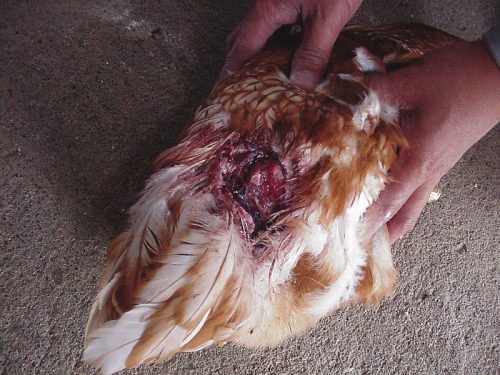Cannibalism (or aggressive pecking)
Cannibalism (or aggressive pecking)
Pecking is the natural means by which poultry investigate their surroundings and establish a stable social order, however, this behaviour can escalate to the stage where birds will literally peck each other to death (cannibalism). All forms of commercial poultry can experience cannibalism as it a behavioural problem that can develop into a habit that will persist and spread within a flock as a learned behaviour, even after the initial causes of the behaviour have been corrected.
What causes cannibalism?
Cannibalism often starts as feather pulling or picking while the birds are only a few weeks old, or as investigative pecking at any age. These behaviours can escalate to aggressive pecking, particularly if an injury occurs. Scientific study has shown that any stressor (or combination of stressors) can trigger this behaviour and can lead to serious aggressive pecking and cannibalism.
These stressors include crowding, bright light intensity, high room temperature, poor ventilation, high humidity, low salt, trace nutrient deficiency, insufficient feeding or drinking space, nervous and excitable birds (hereditary), external parasites, access to sick or injured birds, stress from moving, boredom and idleness, housing birds of different appearance together and birds prolapsing during egg-laying.

Bird seriously injured through pecking
Prevention and treatment of cannibalism
As cannibalism can become a learned behaviour it can be difficult to treat once it has started in a flock. Therefore prevention should be the main aim and as such, good husbandry practices should aim to minimise the stressors listed above as potential causes for cannibalism. Some strains of birds have been shown to have a higher tendency towards developing aggressive pecking behaviour and therefore strains that are more placid should be preferred.
The broad range of factors that can trigger cannibalism can make it very difficult for management to control all of these factors for the entire life of the flock. Bright light is a known factor that leads to cannibalism but control of lighting levels in some poultry housing systems can be very difficult, if not impossible (such as in free range systems). Where outbreaks of cannibalism have occurred in a flock, or where there is a reasonable concern that management strategies can not be guaranteed to prevent an outbreak, then beak trimming of the birds may be used as a control measure. Trimming of the sharp tip of the upper, and sometimes also lower, beak reduces the damage that is caused by aggressive pecking. Further information on the practice of beak trimming can be found in the section on Beak Trimming.
The spread of the behaviour may be able to be controlled if the injured and aggressive birds can be rapidly identified and removed from the flock. Provision of escape areas may also help in floor-housed flocks. Other control methods that have been tested include the use of spectacles to prevent forward vision, bits that prevent complete closure of the beak and coloured contact lenses to prevent the identification of blood on another bird.
There is evidence that cannibalism may be alleviated through the use of high fibre diets. It is believed that high fibre diets enhance gut development and gizzard function, which in turn help reduce aggressive behaviour in hens.
Methods that can be used for controlling cannibalism are discussed in the Model Code of Practice for the Welfare of Animals – Domestic Poultry, which can be obtained from The CSIRO Publishing website.

